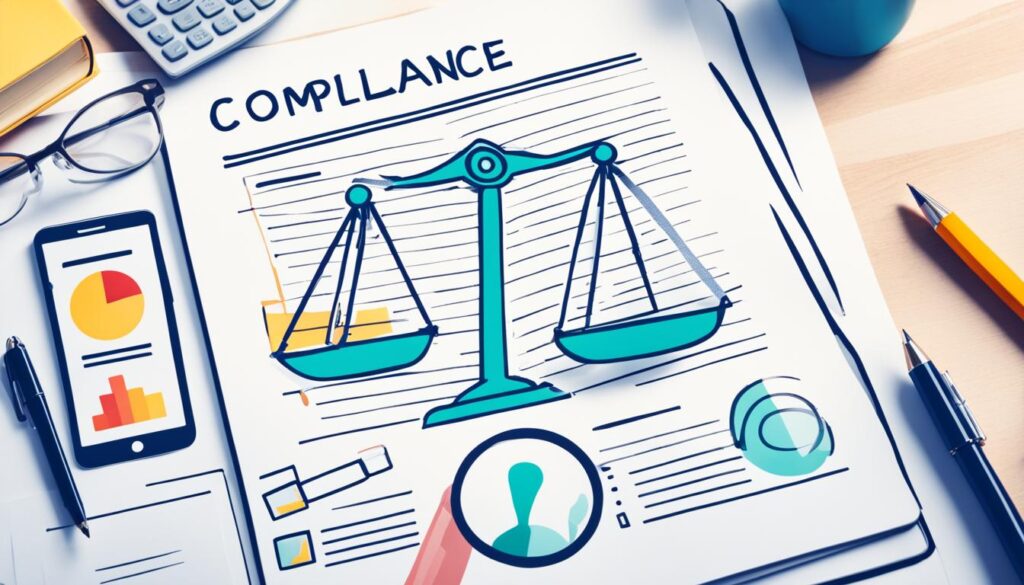Are you ready to use user-generated content wisely and follow the law? Today, UGC is key in shaping how people see a brand and making their buying choices. It includes everything from photos and videos to reviews and social media posts made by customers1.
We’re going to look at UGC laws, legal risks, and how to use content the right way. As companies use UGC to get more people involved and grow online, knowing the law is vital. We’ll cover important parts of UGC rules to help you stay out of trouble and keep your brand looking good.
UGC is a big deal for businesses, helping them connect better with users and sway buying choices2. With 86% of people valuing realness in brands, UGC is a strong way to build trust3. But, companies need to be careful to follow changing rules.
Key Takeaways
- UGC includes many types of content made by customers
- Knowing UGC laws is key for good reputation management
- Following data protection laws is a must
- Respecting user rights when using UGC is important
- Having good content policies can prevent legal problems
- Keeping up with UGC legal changes is necessary
Understanding User-Generated Content (UGC) in the Digital Landscape
User-generated content (UGC) is a big deal in the digital world. It includes things like social media posts, reviews, and videos. By December 2023, billions of people visited websites with UGC, showing how popular it is4. This has changed how brands talk to their audience.
Sites like YouTube and Instagram have helped UGC grow in marketing. They let content creators share their stories and views. Research shows people trust what their peers say more than what brands say5. This trust leads to more loyal customers and more sales.
UGC is great for businesses. It’s a cheap way to make content and gives insights into what customers like. Marketers use UGC in many ways, like influencer campaigns and reviews5. These methods increase engagement and help with search rankings.
But, using UGC has legal stuff to think about. Users often have to give permission for their content, and following data protection laws is key6. Having clear rules and moderation helps make sure everything is legal and keeps users coming back.
Looking into UGC more, it’s clear it’s changing the digital world. Its realness and variety make it a strong tool for both brands and consumers.
Legal Framework Surrounding User-Generated Content
The legal rules for user-generated content (UGC) are complex. They cover copyright laws, privacy rules, and platform-specific rules. UGC includes text, images, videos, reviews, and social media posts7. Social media sites like Facebook, Instagram, and YouTube make it easy for users to share content. This brings up new legal issues7.

Copyright laws are key in managing UGC. People who post videos or photos are usually seen as the copyright owners7. The fair use doctrine lets people use copyrighted stuff without permission in some cases. But, it’s hard to apply7.
In the UK, UGC is covered by copyright law, defamation law, and data protection rules like GDPR and the UK Data Protection Act 20188. The Communications Act 2003 and eCommerce Regulations 2002 set rules for service providers about the content on their sites8.
Using UGC for ads can lead to legal problems. It’s important to get the right permission and pay for it to avoid legal trouble7. Platforms hosting UGC need to have ways to deal with copyright issues and teach creators about their rights7.
In India, the Information Technology Act, 2000 sets rules for digital content and points out the responsibility of platforms9. Platforms must have strict rules to fight hate speech and online bullying. They need to balance removing content with protecting free speech9.
Businesses using UGC should make clear rules, have strong moderation, and teach their staff about legal issues8. By following these legal guidelines, companies can use UGC safely and legally.
User-Generated Content Regulations: Key Compliance Areas
Understanding user-generated content (UGC) rules is key for businesses using this powerful marketing tool. With 74% of customers using social media to decide what to buy, UGC greatly affects how people see a brand10. Let’s look at the main rules for handling UGC legally and ethically.
Content moderation is a big part of UGC rules. It’s important to have strong policies and tools to block spam and bad content. This keeps the brand’s image good and makes users happy.

Stopping copyright infringement is also crucial. Making sure to respect content rights and get the right permissions is key for both creators and businesses. This means setting up clear licensing deals and teaching users about intellectual property rules.
Data protection laws, like GDPR, require being open about how data is handled and getting user consent. Companies must put user privacy first and follow strict rules for storing and using data11. It’s important to have detailed terms of service that explain how UGC can be used and what users need to do.
| Compliance Area | Key Focus | Implementation Strategy |
|---|---|---|
| Content Moderation | Filtering inappropriate content | Automated tools and human review |
| Copyright Protection | Respecting intellectual property | Clear guidelines and permission systems |
| Data Protection | User privacy and consent | Transparent policies and secure data handling |
| Terms of Service | Legal requirements and user rights | Comprehensive, easy-to-understand agreements |
By focusing on these key areas, businesses can use UGC effectively while following the law. This not only keeps the company safe but also builds trust with users. It creates a strong community around the brand.
Best Practices for UGC Moderation and Management
Managing user-generated content (UGC) well is key. Make sure moderation fits with your brand’s goals and values. This helps build a positive online community. Clear community guidelines are also important. They tell users what kind of content is okay.
Using management platforms makes moderating UGC easier. Tools like content management systems and social media tools help handle lots of content. For example, Refunnel helps keep track of UGC tags from different social media sites. Zelf also helps in getting content licenses from creators, with a 65% success rate12.

It’s important to balance moderation. Use automated filters and human checks together. This way, you can make quick decisions and still consider the context. Since 86% of people trust UGC more than influencer ads, making sure content is real is crucial13.
Teaching users to create content responsibly is vital. Let them know how to report bad content. This helps reduce harmful content and makes the user experience better.
“Encouraging positive and respectful behavior among users creating or sharing UGC is essential for fostering a positive online community.”
Following these best practices has big benefits. UGC can boost online sales by 15%, and UGC photos are 5 times more likely to make people buy something14. By managing UGC well, businesses can use its power safely and keep their online space engaging141312.
Leveraging UGC While Maintaining Compliance
UGC campaigns are a great way to connect with our audience and boost our marketing. They let us use real content from users to build trust and increase sales. Research shows that 86% of millennials trust UGC to show a brand’s quality, and 84% let it influence their buying choices15.
To make the most of UGC, we should focus on:
- Creating branded hashtags to increase visibility
- Running contests to get more people involved
- Showing off user reviews and testimonials
- Adding UGC to our website and emails
These steps can help us reach more people without spending a lot on ads16.
When using UGC in social commerce, remember that 92% of people prefer real content over ads. This leads to a 29% increase in web sales for campaigns using UGC17.
To keep things legal while using UGC, we should:
- Get the okay from content creators
- Have clear rules for the community
- Use tools to keep an eye on brand mentions
- Look at UGC data to see how it changes brand image
By doing this, we can use UGC’s power without breaking any laws or ethical rules. This way, we get to use cost-effective, real content that speaks to our audience and helps our influencer marketing.
| UGC Impact | Percentage |
|---|---|
| Millennials trust UGC for brand quality | 86% |
| UGC influences millennial purchasing decisions | 84% |
| Consumers prefer UGC over traditional ads | 92% |
| Average increase in web conversions with UGC | 29% |
Challenges in UGC Regulation Compliance
User-generated content (UGC) is key in digital marketing, adding realness and connection. But, it comes with big legal risks for businesses18. Issues range from copyright issues to privacy worries, making things tough and complex19.
Handling content moderation is a big challenge. UGC boosts engagement and trust, but it needs a lot of work to keep it good20. Companies must set rules and use tools to keep out bad content. This takes a lot of time and effort20.

Dealing with negative feedback and managing crises is hard too. Brands need to quickly handle criticism and protect their reputation. This is a tricky balance between solving problems and keeping the brand consistent20.
Staying legal is always a worry. Copyright laws protect UGC from the start, so getting permission is key for using it in ads18. If there’s copyright infringement, you might need to take down content18.
| Challenge | Impact | Mitigation Strategy |
|---|---|---|
| Content Moderation | Resource intensive, prone to errors | Implement automated tools, clear guidelines |
| Legal Risks | Potential lawsuits, fines | Obtain explicit permissions, educate team |
| Negative Feedback | Reputation damage | Swift response, crisis management plan |
| Privacy Concerns | Regulatory fines, user trust loss | Adhere to data protection laws, transparency |
Dealing with these challenges needs a full plan. Keeping an eye on things, having clear rules, and teaching your team are key. This helps stay in line with the law and use UGC well18. By tackling these problems early, businesses can lower risks and make a good space for user interaction.
Conclusion
In today’s digital world, knowing how to handle user-generated content (UGC) is key for managing your reputation. UGC can greatly increase trust in a brand and get customers more involved, with 92% of people preferring it over traditional ads for its realness21. This shows how important a good UGC strategy is for a strong online image.
Dealing with the legal side of UGC is tricky but vital. Brands need clear permission to use content, shown by a $2.5 million FTC fine for false UGC use22. Tools like Flowbox help by offering templates for getting rights, letting users say yes with certain hashtags23. These steps help follow the law and build good community ties, which are key for keeping a good reputation.
The future success depends on using UGC wisely while following the rules. By using smart moderation and management, companies can use UGC’s strength safely. Remember, 88% of consumers look for realness when picking brands21. As laws and platform rules change, being flexible and focused on users will help keep trust and engage customers with UGC.
FAQ
What is user-generated content (UGC)?
Why is UGC important for businesses?
What are the legal considerations surrounding UGC?
What are the key compliance areas for UGC?
What are best practices for UGC moderation and management?
How can businesses leverage UGC while maintaining compliance?
What challenges do businesses face in UGC regulation compliance?
Source Links
- User-generated content (UGC): Everything you need to know – https://emplifi.io/what-is-user-generated-content
- User Generated Content: A Reputation Management Strategy – https://www.reputationsciences.com/user-generated-content-reputation-management/
- Join the Social Conversation: 10 Tips for Leveraging User-Generated Content – Reputation – https://reputation.com/resources/articles/join-the-social-conversation-10-tips-for-leveraging-user-generated-content/
- The Power of User Generated Content (UGC): A Complete Guide – Startup Geek – https://startupgeek.com/blog/ugc/
- Slide 1 – https://www.iab.com/wp-content/uploads/2015/07/IAB_Digital_Simplified_UGC_Final.pdf
- Navigating the Legal Landscape of User-Generated Content – https://medium.com/@islandhyped/navigating-the-legal-landscape-of-user-generated-content-9d2f6039c263
- IP And usage Rights For User-Generated Content (UGC) – Fashion Law Journal – https://fashionlawjournal.com/ip-and-usage-rights-for-user-generated-content-ugc/
- Understanding the Legalities of User-Generated Content in the UK – Legal Foundations – https://legalfoundations.org.uk/blog/understanding-the-legalities-of-user-generated-content-in-the-uk/
- Liability of Digital Platforms: Navigating Legal Challenges in the Age of User-Generated Content – https://www.linkedin.com/pulse/liability-digital-platforms-navigating-legal-challenges-4r6kc
- What Is User-Generated Content (UGC)? – https://besedo.com/blog/user-generated-content-ugc/
- GDPR, trust and user-generated content at work – https://www.storytagger.com/resources/gdpr-trust-and-user-generated-content-at-work/
- What are the best practices for moderating user-generated content? – https://www.linkedin.com/advice/0/what-best-practices-moderating-user-generated-4ouuc
- The Art of Balancing Freedom and Responsibility: User-Generated Content Management Strategies – Chekkee – https://chekkee.com/the-art-of-balancing-freedom-and-responsibility-user-generated-content-management-strategies/
- User Generated Content: The Complete Guide to UGC Marketing – https://getflowbox.com/guide/user-generated-content/
- Remaining Compliant with User-Generated Content – https://www.parkip.com/remaining-compliant-with-user-generated-content/
- Leveraging User-generated Content for Brand Growth – https://www.theadfirm.net/leveraging-user-generated-content-for-brand-growth/
- Leveraging UGC Platforms to Outsource Social Media Video Ad – https://leadsync.me/blog/ugc-platforms/
- The Legal Aspect Of UGC: Ensuring Compliance – https://niftycomms.com/the-legal-aspect-of-ugc-ensuring-compliance/
- Navigating Legal and Ethical Compliance in User-Generated Content – https://www.linkedin.com/pulse/navigating-legal-ethical-compliance-user-generated-content-henry-dpp6e
- Pixelbin – https://www.pixelbin.io/guidebook/top-5-challenges-in-user-generated-content
- UGC Content 101: A Comprehensive Introduction – https://www.ama.org/marketing-news/user-generated-content/
- How To Legally Use User-Generated Content – https://terms.law/2023/09/14/how-to-legally-use-user-generated-content/
- User Generated Content Permission, Rights, Laws & Legal Issues – https://getflowbox.com/blog/user-generated-content-permission/

